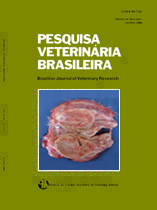 |
|
|
|
Year 2017 - Volume 37, Number 5
|

|
Retrospective study of cases of Buff-necked Ibis (Theristicus caudatus) treated by the veterinary care project of wild animals of Santa Catarina plateau during the years 2003-2014, 37(5):511-515
|
ABSTRACT.- Bach E.C., Costa A., Lunardeli B., Baldni M.H.M., Oleskovicz N., Casagrande R.A. & Moraes A.N. 2017. [Retrospective study of cases of Buff-necked Ibis (Theristicus caudatus) treated by the veterinary care project of wild animals of Santa Catarina plateau during the years 2003-2014.] Estudo retrospectivo da casuística de Curicacas (Theristicus caudatus) recebidas pelo Projeto de Atendimento a Animais Selvagens do Planalto Catarinense no período de 2003-2014. Pesquisa Veterinária Brasileira 37(5):511-515. Hospital de Clínicas Veterinárias, Centro de Ciências Agroveterinárias, Universidade do Estado de Santa Catarina, Av. Luiz de Camões 2090, Lages, SC 88520-000, Brazil. E-mail: a2anm@cav.udesc.br
This paper describes a retrospective study of all cases of Buff-necked Ibis (Theristicus caudatus) treated by the veterinary care project of wild animals of Santa Catarina plateau during the years 2003 to 2014. In this period 77 Buff-necked Ibis were treated, all of them were free living animals from Santa Catarina plateau. It was found that, 33.7% were young animals, 16.8% were adults and 49.5% indeterminate age. About these animals, 22.1% were males, 14.3% were females and the other ones undefined. About the clinical disorders, 55.8% had bone fracture, 9.1% demonstrated neurological disorders, 3.9% multiples lacerations in skin and muscles, 3.9% demonstrated dislocation of member 3.4% demonstrated oral bleeding. Air sac rupture was observed in 2.6% of the animals, 2.6% were dyspneic and 2.6% had diarrhea, 1.3% peritonitis. In 20.8% of the cases the animal only demonstrated unspecific signs such as malnutrition. Of the animals treated, 55.8% came to death, 28.6% were euthanized, 5.2%were treated an sent to IBAMA or to a sorting center for wild animals. 2.6% were released into the wild, and in 7.8% of the cases de destination was not informed. Necropsy was performed in 70.8% of the animals, wherein 82.6% of those birds had came to a definitive diagnosis of trauma and in 2.2% the diagnosis was peritonitis caused by a gizzard perforation by a metallic foreign body. And 2.2% came to death for pneumonia caused by a foreign body (projectile). The high mortality of birds may be related with the severity of the lesions and with disorders resulting from trauma. The buff-necked ibis was the specie that presented the highest number of treatment by this project during the period described in the study. This information demonstrated that studding the disorders of this bird can serve as an indicator of the the risk which other bird species in the region are suffering. |
| |
|
|
| |
|
 |